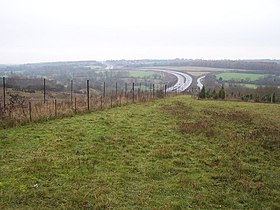Twyford Down
| Twyford Down | |
|---|---|

Twyford Down in November 2005, with the M3 in the background
|
|
| Highest point | |
| Elevation | 142 m (466 ft) |
| Listing | (none) |
| Coordinates | 51°02′41″N 1°16′47″W / 51.04463°N 1.27959°WCoordinates: 51°02′41″N 1°16′47″W / 51.04463°N 1.27959°W |
| Geography | |
| Location | South Downs, England |
| OS grid | SU506275 |
| Topo map | OS Landranger 185 |
Twyford Down is an area of chalk downland lying directly to the southeast of Winchester, Hampshire, England. It is situated near the South Downs National Park, next to St. Catherine's Hill. The down has been used as a settlement since pre-Roman times, and has hosted a fort and a chapel, as well as being a popular 17th and 18th century coaching route.
In 1991, the down became the site of a major road protest against the completion of a section of the M3 motorway from London to the south coast of England. There had been plans since the 1970s to replace an earlier 1930s-built bypass of Winchester, which became regularly congested due to design features that had become out of date. This became problematic due to the lack of available land between Winchester College and St. Catherine's Hill. After several public inquiries, particularly with problems using the water meadows near the college, a route was chosen that took the motorway over the down, ultimately in a cutting. Although protesting against the M3 had been ongoing since the early 1970s, the protest-action on top of the down, described in 1994 as the most controversial British motorway project ever to start construction, attracted a wider group of classes of people than had previously been the case, and included physical violence from onsite security officers.
The motorway was completed as planned, and provided an important link of continuous motorway between Greater London and the South Coast ports. Nevertheless, the protests attracted interest from the national media, and drew attention to this form of campaigning. Subsequent road schemes were altered to take greater account of the environment or cancelled altogether. Several protesters at Twyford Down subsequently went on to form campaign groups such as the Campaign for Better Transport.
...
Wikipedia

